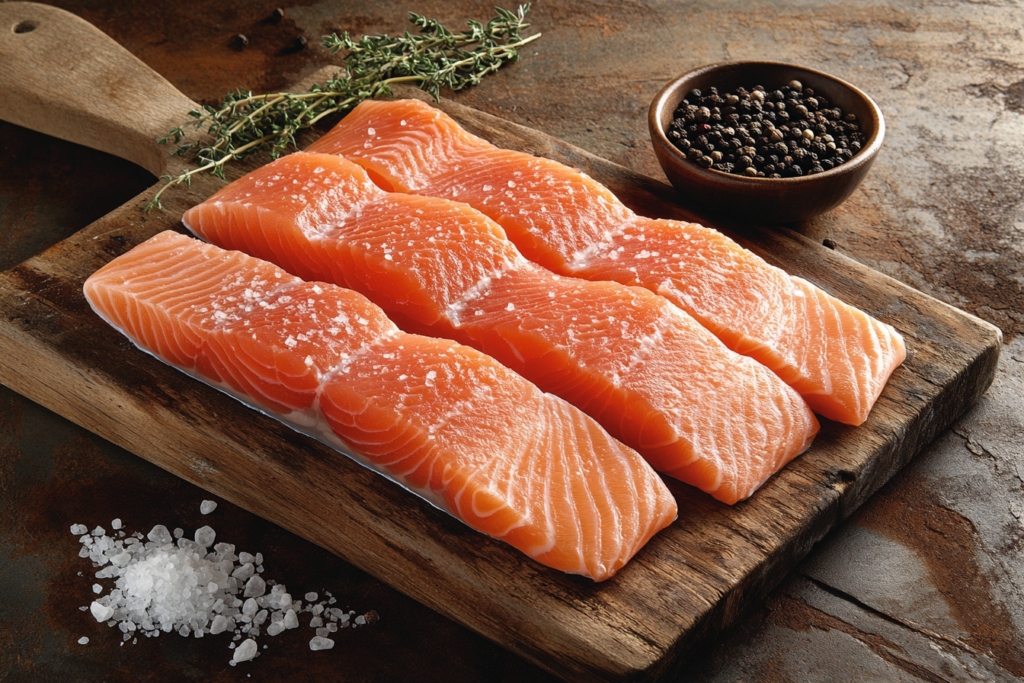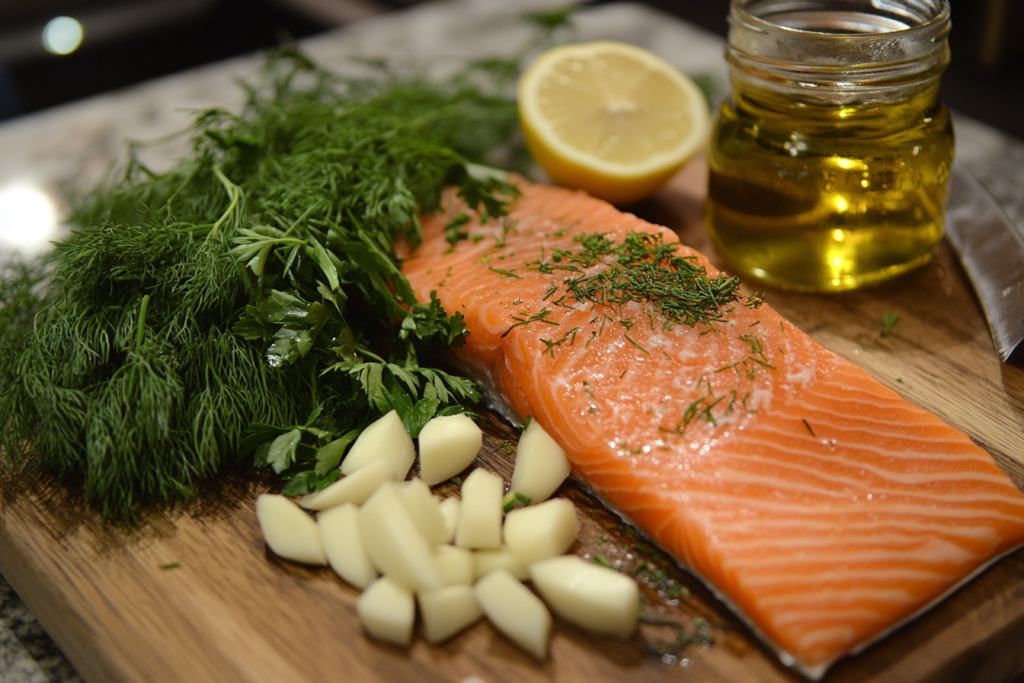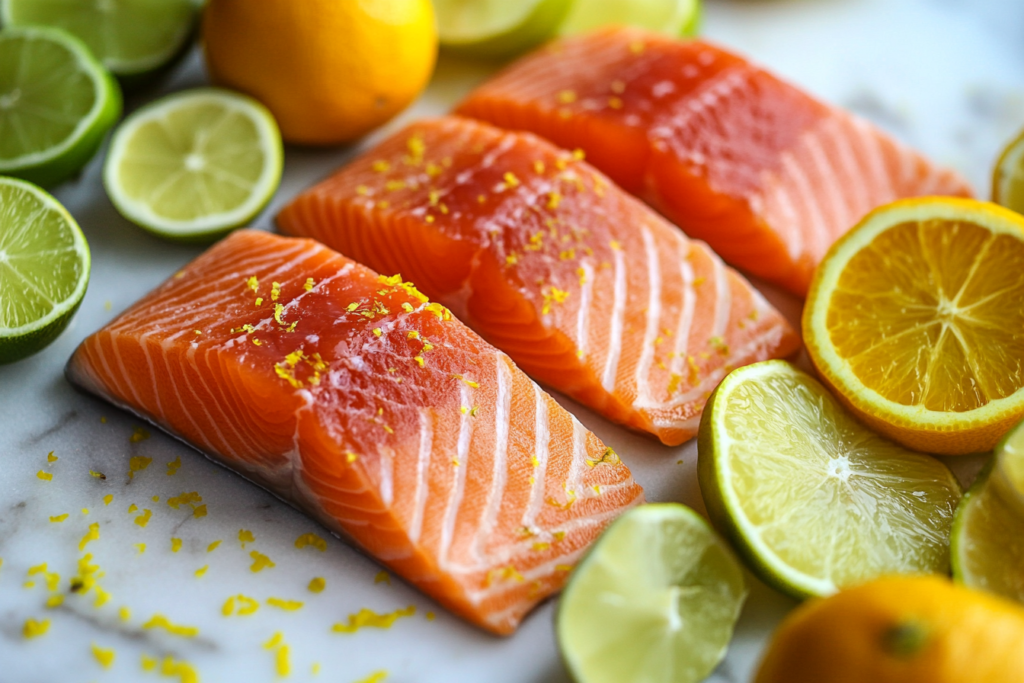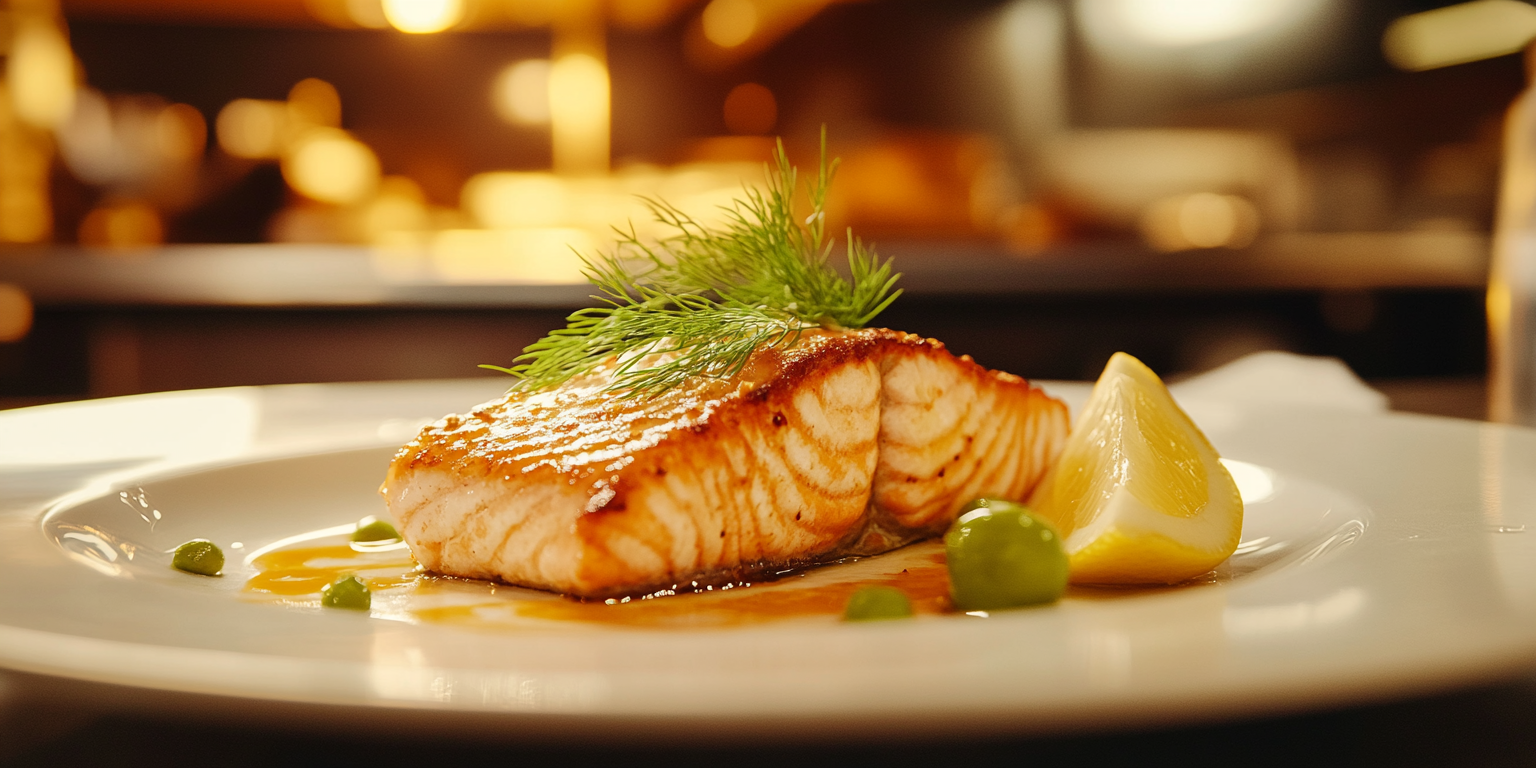What Does Gordon Ramsay Season Salmon With?
If you’re curious what does Gordon Ramsay season salmon with, this article will break it all down. Whether it’s crispy pan-seared salmon or a tender baked fillet, Gordon Ramsay’s techniques will show you how to take your cooking to the next level. Stick around to discover exactly what Gordon Ramsay seasons salmon with and how you can recreate his magic in your kitchen!
The Foundation of Gordon Ramsay Salmon Seasoning: Salt and Pepper
Let’s start with the basics. Every great dish needs a solid foundation, and for Gordon Ramsay, that begins with salt and freshly cracked black pepper. These essential seasonings highlight the fish’s natural flavor, but that’s just the beginning when it comes to what does Gordon Ramsay season salmon with.

- Salt: Ramsay prefers using sea salt or kosher salt. These salts have larger grains than table salt, which makes them perfect for evenly seasoning the fish. The coarser texture also creates small bursts of flavor as you bite into the salmon.
- Pepper: He insists on freshly cracked black pepper instead of pre-ground pepper, as it has a more vibrant and aromatic flavor.
These two simple ingredients might sound unremarkable, but they’re essential for bringing out the natural richness of the salmon. Skipping or under-seasoning with salt and pepper is one of the most common mistakes people make, so don’t skimp here!
Herbaceous Boost: How Gordon Ramsay Seasons Salmon with Garlic and Herbs
If there’s one thing Gordon Ramsay knows how to do, it’s layer flavors. After the salt and pepper, he turns to fresh aromatics like garlic and herbs. These ingredients add depth and complexity without overpowering the fish. When thinking about what does Gordon Ramsay season salmon with, herbs like these are always at the top of his list.

The Best Herbs in Gordon Ramsay Salmon Seasoning:
- Dill: A classic pairing with salmon, dill’s light and slightly sweet flavor complements the fish perfectly.
- Thyme: With its earthy and lemony notes, thyme adds a subtle brightness to the dish.
- Parsley: Fresh parsley provides a clean, fresh taste that enhances the other flavors.
Garlic is another favorite. Ramsay often uses minced garlic rubbed onto the fillet or sautéed in olive oil for a delicate infusion of flavor. Combined with herbs, it’s a foolproof way to elevate the dish.
Bright and Zesty: Citrus in the Best Salmon Seasoning by Gordon Ramsay
One of Ramsay’s most notable tricks is his use of citrus. A touch of lemon, lime, or orange can make salmon feel light and vibrant, perfectly balancing its buttery richness.
- Zest: Ramsay often grates lemon or lime zest over the salmon. Zest contains the essential oils of the fruit, which are packed with bright, aromatic flavors.
- Juice: He squeezes fresh lemon or lime juice either before cooking to tenderize the fish or after cooking as a finishing touch for acidity.

For a unique twist, he sometimes incorporates orange zest for a slightly sweeter, tangier flavor profile. This is particularly delightful if the salmon is glazed or paired with a sweet component like honey.
The Role of Olive Oil
Before cooking, Ramsay always drizzles the salmon with a bit of extra virgin olive oil. It’s not just about adding flavor; the oil serves multiple purposes:
- It helps the seasoning stick to the fish.
- It creates a beautiful golden crust when the salmon is seared.
- It keeps the fish moist during cooking.
Let’s not forget olive oil, a key element in what does Gordon Ramsay season salmon with.
Adding Some Heat: Paprika and Chili Flakes
When Ramsay wants to spice things up, he reaches for smoked paprika or chili flakes.
- Smoked paprika: This adds a warm, smoky flavor that pairs beautifully with salmon’s natural richness. It’s especially good when the salmon is grilled or roasted.
- Chili flakes: For a little kick, chili flakes provide a gentle heat that doesn’t overpower the dish.
If you’re a spice lover, you can dial up the heat. Otherwise, go light on the chili flakes and let the paprika do the talking.
Sweet Touches: Honey and Maple Syrup
A touch of sweetness can elevate salmon to the next level, and Ramsay is a big fan of using honey or maple syrup in his recipes.
- Honey: This natural sweetener is often combined with garlic, lemon, or soy sauce to create a sticky, caramelized glaze.
- Maple syrup: This works particularly well in recipes that include smoky or spicy flavors, like smoked paprika or chili flakes.
When cooked, these sweet elements form a golden crust that’s as beautiful as it is delicious.
Umami Depth: Mustard and Soy Sauce
To add complexity, Ramsay often includes Dijon mustard or soy sauce in his seasoning arsenal.
- Dijon mustard: A thin layer of mustard spread over the salmon creates a tangy, flavorful crust. It pairs exceptionally well with herbs and citrus.
- Soy sauce: Ramsay sometimes uses soy sauce in a marinade or glaze, especially when he’s going for a sweet-and-savory profile. Soy sauce’s salty umami flavor adds depth and richness to the dish.
These ingredients might not be traditional for salmon, but they highlight Ramsay’s innovative approach to seasoning.
Cooking the Salmon Gordon Ramsay-Style
Seasoning is only half the battle. How you cook salmon is just as important, and Gordon Ramsay has a tried-and-true method that guarantees perfection every time.
Step 1: Start with a Hot Pan
Ramsay insists on preheating the pan before adding the salmon. A hot pan ensures the fish gets a perfect sear and the skin turns crispy.
Step 2: Cook Skin-Side Down First
Cooking the salmon skin-side down locks in moisture and helps the fish cook evenly. Ramsay advises pressing the fillet down gently with a spatula for the first 30 seconds to prevent it from curling up.
Step 3: Finish in the Oven (Optional)
For thicker fillets, Ramsay often transfers the salmon to a preheated oven to finish cooking. This ensures the fish cooks evenly without drying out.
Timing is Everything
The key to perfect salmon is not overcooking it. The fish should flake easily with a fork but still be slightly translucent in the center. Ramsay typically cooks salmon for 3–4 minutes per side, depending on the thickness.
The Finishing Touches
Once the salmon is perfectly cooked and seasoned, Ramsay adds a few final flourishes to make the dish truly shine:
- Herbs: A sprinkle of fresh dill, parsley, or chives adds color and flavor.
- Zest or Juice: A final hit of lemon zest or juice brightens the dish and balances the richness of the fish.
- Sauce: Ramsay often serves his salmon with a complementary sauce, like a lemon-butter reduction, yogurt dill dressing, or even a soy-based glaze.
A Gordon Ramsay-Inspired Recipe to Try
Ready to bring Ramsay’s techniques into your own kitchen? Here’s a simple recipe to get you started.
Ingredients:
- 2 salmon fillets
- 1 tablespoon olive oil
- Salt and freshly cracked black pepper
- 1 teaspoon smoked paprika
- Zest of 1 lemon
- 1 tablespoon honey
- 2 cloves garlic, minced
- Fresh dill, for garnish
Instructions:
- Preheat a skillet over medium-high heat and add olive oil.
- Pat the salmon fillets dry and season generously with salt, pepper, and smoked paprika.
- Place the salmon skin-side down in the pan and cook for 3–4 minutes until the skin is crispy.
- Flip the fillets and cook for another 2–3 minutes.
- Add garlic and honey to the pan, letting the mixture caramelize slightly. Spoon the glaze over the salmon as it finishes cooking.
- Remove from heat and garnish with lemon zest and fresh dill before serving.
Why Gordon Ramsay’s Methods Work
What makes Gordon Ramsay’s approach to salmon so effective? It’s all about balance. His techniques focus on enhancing the fish’s natural flavor with complementary ingredients rather than overwhelming it. By layering flavors—starting with salt and pepper, adding aromatics and citrus, and finishing with sweet or spicy elements—Ramsay creates a complex and harmonious dish. If you’ve been wondering what does Gordon Ramsay season salmon with, it’s all about creating a balance of salt, herbs, and bold accents like citrus and paprika.
When exploring Gordon Ramsay’s approach to seasoning salmon, it’s essential to consider complementary methods to elevate your salmon dishes. For example, pairing his seasoning techniques with creative sauce options for salmon can further enhance the flavor profile. Additionally, if you’re curious about different cooking methods, our guide on butter vs. oil for cooking salmon provides valuable insights into achieving the perfect sear and texture. For a lighter snack or appetizer, you might want to try crafting salmon bites—easy and tasty snacks that carry Ramsay-inspired seasoning into a new context.
FAQs
What is the Best Thing to Season Salmon?
When it comes to seasoning salmon, simplicity is key. You want to enhance the fish’s natural, buttery flavor without overpowering it. The best basic combo? Sea salt and freshly cracked black pepper. They bring out the fish’s natural richness and create the perfect foundation for adding other flavors.
Want to level up? Add a squeeze of lemon juice or a sprinkle of lemon zest for some brightness, and finish it with a drizzle of good-quality olive oil to keep things moist and flavorful. If you’re feeling adventurous, try smoked paprika for a smoky depth or a pinch of chili flakes to bring in some heat.
What Herb or Spice Goes Well with Salmon?
Salmon pairs beautifully with a variety of fresh herbs and spices, making it incredibly versatile. Some of the top herbs include:
- Dill: The ultimate salmon partner, offering a fresh, slightly sweet flavor.
- Thyme: Its earthy, citrusy notes complement the fish perfectly.
- Parsley: Clean and mild, parsley works as a great garnish or mix-in for sauces.
- Chives: Adds a subtle onion-like flavor that doesn’t overwhelm.
Spices? Salmon loves a little bit of boldness. Try:
- Smoked paprika: For a smoky, slightly sweet kick.
- Garlic powder: A classic for a savory punch.
- Cumin: Adds a warm, earthy note if you’re going for a more unique or unfamiliar flavor profile.
- Chili flakes or cayenne: Perfect for a hint of heat.
What Makes Salmon Taste Better?
A few small tricks can take salmon from good to great:
- Citrus: A squeeze of fresh lemon, lime, or orange brightens up the richness of the fish. Zest is a secret weapon—grating it directly over cooked salmon adds an extra layer of flavor.
- Sweetness: Drizzle a little honey or maple syrup on your salmon before cooking for a caramelized crust that contrasts beautifully with the savory elements.
- Marinades: Soaking the salmon in a mix of soy sauce, garlic, ginger, and a dash of sesame oil gives it an umami boost.
- Crispy Skin: Cook the salmon skin-side down in a hot pan until it’s golden and crispy. That crunch adds a whole new textural experience.
- Herbs and Butter: A pat of garlic herb butter melting over warm salmon is chef’s kiss.
What Oil Does Gordon Ramsay Use for Salmon?
Gordon Ramsay’s go-to oil for cooking salmon is extra virgin olive oil. He uses it for both flavor and function. Olive oil helps create that signature crispy skin when the fish is seared in a hot pan. Plus, its fruity and slightly peppery flavor enhances the fish without overpowering it.
Ramsay also sometimes incorporates neutral oils like vegetable or grapeseed oil if cooking at very high heat (since these oils have a higher smoke point), but olive oil is his favorite for most salmon dishes. To finish, he might drizzle a little more olive oil over the fish just before serving for a final touch of richness.
There you go! With these tips, you’ll have salmon seasoned and cooked like a pro in no time.
Conclusion
Cooking salmon like Gordon Ramsay doesn’t require a Michelin star or years of training—just a few simple techniques and a willingness to experiment. By focusing on fresh, high-quality ingredients and layering flavors thoughtfully, you can transform a humble piece of fish into a dish that’s worthy of a fine dining experience. Whether you’re cooking for a special occasion or just spicing up a weeknight dinner, these tips will help you take your salmon game to the next level.
So, grab your skillet, season with confidence, and channel your inner Ramsay. Your taste buds—and anyone you’re cooking for—will thank you!

